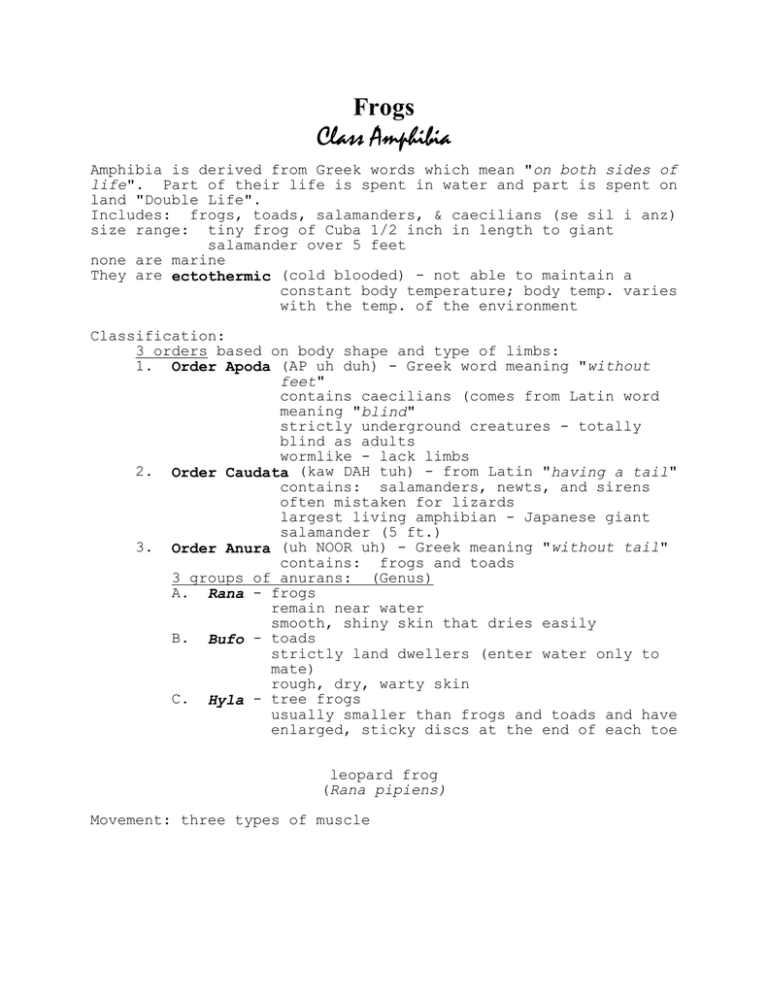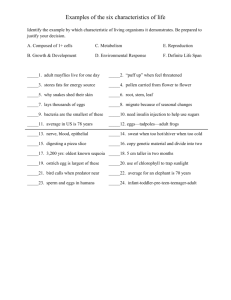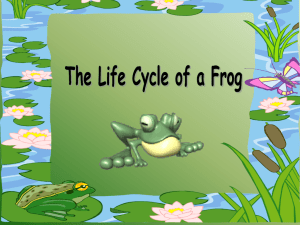Class Amphibia Frogs
advertisement

Frogs Class Amphibia Amphibia is derived from Greek words which mean "on both sides of life". Part of their life is spent in water and part is spent on land "Double Life". Includes: frogs, toads, salamanders, & caecilians (se sil i anz) size range: tiny frog of Cuba 1/2 inch in length to giant salamander over 5 feet none are marine They are ectothermic (cold blooded) - not able to maintain a constant body temperature; body temp. varies with the temp. of the environment Classification: 3 orders based on body shape and type of limbs: 1. Order Apoda (AP uh duh) - Greek word meaning "without feet" contains caecilians (comes from Latin word meaning "blind" strictly underground creatures - totally blind as adults wormlike - lack limbs 2. Order Caudata (kaw DAH tuh) - from Latin "having a tail" contains: salamanders, newts, and sirens often mistaken for lizards largest living amphibian - Japanese giant salamander (5 ft.) 3. Order Anura (uh NOOR uh) - Greek meaning "without tail" contains: frogs and toads 3 groups of anurans: (Genus) A. Rana - frogs remain near water smooth, shiny skin that dries easily B. Bufo - toads strictly land dwellers (enter water only to mate) rough, dry, warty skin C. Hyla - tree frogs usually smaller than frogs and toads and have enlarged, sticky discs at the end of each toe leopard frog (Rana pipiens) Movement: three types of muscle Body Covering: skin 3 functions of amphibians' skin: 1. body covering 2. protection a. secretes poisonous substances may just taste bad may be strong enough to burn may be fatal Arrow poison frog Read page 456 (To be effective, the toxin must enter the bloodstream directly; digestive enzymes destroy the toxin, making it safe to consume poisoned game.) b. camouflage chromatophores 3. respiration Support: endoskeleton Nutrition: Flips out its long sticky tongue & snatches prey. Then it flips the tongue and insect into its mouth. teeth: 2 sets in upper jaw maxillary (MAK suh lehr ee) vomerine (VO mur in) teeth are not used to chew or bite food function - helps to hold prey To swallow: uses blinking eyes to help force food down the gullet path of food: esophagus stomach (pyloric valve) small intestine (duodenum to ileum) colon (large intestine) cloaca (klo AY kuh) - the cavity which collects and stores wastes from both the colon and kidneys anus two glands which are part of the frog's digestive system: liver - largest organ in the frog produces bile (stored in gallbladder) pancreas mesenteries - transparent membranes that surround body organs and attach them to the body wall Respiration: 4 structures which amphibians use to obtain oxygen (1) gills - used during the aquatic stage (2) lungs - used by terrestrial adults lack a rib cage and diaphragm (fill their lungs by forcing air into them by lowering the floor of (3) (4) its mouth and swallowing air) the lining of the adult's mouth and throat has an abundant blood supply and can exchange gases the skin used especially in lungless amphibians also while an amphibian is underwater for a long period of time skin accounts for a great part of respiration Circulation: 3-chambered heart 1 ventricle (pumps blood to all parts of the body) 2 atria left atrium - oxygenated blood from lungs right atrium - deoxygenated blood from body dorsal aorta - largest blood vessel in the frog vena cava - largest vein in the frog Excretion: kidneys (filter wastes and excess water and concentrate them in the form of urine) renal arteries / renal veins ureter urinary bladder cloaca anus Responses: 2 major divisions of the nervous system: (1) central nervous system (CNS) brain and spinal cord (2) peripheral nervous system (PNS) cranial nerves spinal nerves sensory organs eyes - nictitating membrane - "third eyelid" ear - tympanic membrane - "eardrum" Reproduction: external fertilization male - testes produce sperm female - ovaries produce ova (eggs) mating process: male crocks to attract a mate she responds when her eggs are ripe amplexus - in the water, the male clasps the female from behind which stimulates the release of eggs (Latin - "embrace" male covers the eggs with sperm both parents usually abandon the eggs Although some female toads lay their eggs one at a time, most toads lay them in a long string, which they spread over plants in the water. Frogs lay eggs in clusters, which are usually anchored to vegetation. Some tropical species attach their eggs to the underside of leaves growing over water. As the eggs hatch, the tadpoles drop into the water. Even though some species lay thousands of eggs at a time (the arrow-poison frog lays a single eg), many eggs are eaten by larger water animals, and therefore only a few reach maturity. The eggs are hatched in 2 to 25 days, depending on the water temperature; low temperatures slow down development. The American white-lipped frog lays its eggs in a hole near a pond, then whips the jellylike substance into a foam in which the tadpoles live until rain washes them into the pond. The Surinam toad of South America lays its eggs and then quickly loops around to catch them on its back; they remain in cavities on the female's back throughout their larval sate. The male midwife toad of western Europe carries the eggs wound around his hind legs. When the eggs are ready to hatch, the male toad enters water and the tadpoles swim away. After the female Darwin's frog lays eggs, the male frog picks up the eggs with his tongue and carries them around in his vocal sac, where they hatch and the young develop. A few species lay their eggs on land under rocks, logs, or dead leaves. These amphibians, such as the barking frog and the cliff frog that live on rocky cliffs in Texas, have no tadpole stage; they hatch from the eggs and begin life as a terrestrial animal.






